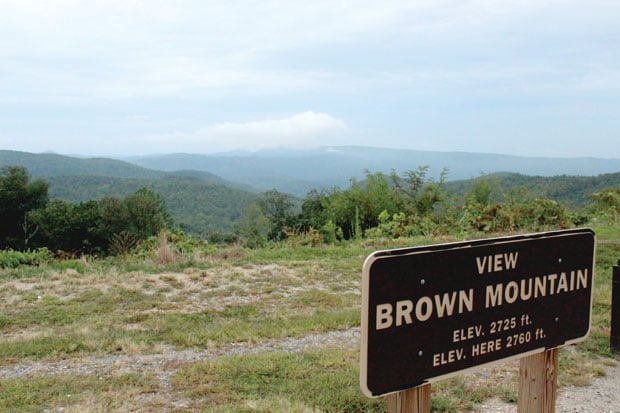For centuries the Brown Mountain Lights have intrigued, haunted, and perplexed those who have witnessed the strange and inexplicable lights hovering over the long, broad peak of Brown Mountain in Burke County, N.C. One of the earliest recorded sightings of the lights was by Geraud de Brahm, a German engineer who explored the region in 1771. Since then, thousands of people are believed to have seen the lights, and countless legends have attempted to explain what many scientists and geologists could not.
However, a recent study of the lights led by scientist Josh Warren has produced a compelling new explanation that he believes could help finally solve the mystery.
Warren believes that a number of unique environmental factors specific to the region surrounding Brown Mountain all coalesce to trigger the phenomenon. He argues that the Brown Mountain Lights are likely a form of plasma naturally produced by the mountain. Plasma is the product of high-level energy being added to a gas, ripping electrons from atoms to produce a swirling, luminous mass of free-floating electrons.
The study gained acclaim within parts of the scientific community and was hailed by the U.S. Naval Physics Laboratory.
While Warren acknowledges that he has yet to fully understand and predict exactly what causes the lights to happen on some nights and not others, he has discovered several factors that he believes increase the likelihood of seeing the lights.
One factor is the amount of activity in the magnetosphere, the magnetic field that surrounds earth. Like the northern lights, the Brown Mountain Lights are the product of something that is cosmically oriented. “Brown Mountain is one of those spots that conducts a lot of energy. Because of that, sometimes we get to see these remarkable little anomalies that illustrate just how strange and powerful our universe really is.”
In essence, the mountain might be acting as a large conductor of electricity. When the lights appear, they are accompanied by electromagnetic interference.
He wasn’t the first to come to this discovery. In the 1970s, a research group comprised of scientists from the Oak Ridge Laboratory studied the lights and came to the same conclusion: “It appears the mountain is able to store up small electrical charges up to a critical point when they then discharge. The end result is a natural phenomenon that produces an effect very similar to ball lightning.”
The mountain is composed of alternating layers of conductive rocks like magnetite and non-conductive rocks (like quartz), magnifying the mountain’s potential to store electrical charges. Add higher water tables after a period of rain and the electric current becomes that much stronger.
During his research, which consisted of hundreds of visits to the area over several years, Warren found that the lights were seen most often in September and October. He hypothesizes that the release of tannic acids by freshly fallen leaves increases the level of electrolytes in the water and makes it more electrically conducive.
Autumn’s larger temperature differential between day and night also squeezes rock layers and increases electrical discharge. Smoke from wood-burning fires can also fuel the lights.
Once the lights appear, Warren said they begin to move parallel along the shelves of earth where the charges originate and also rise straight up into the air. The way the lights move and react still remains unexplained.
“They could rise due to their own heat, a sort of Jacob’s Ladder effect, or it could be that they are at times even more influenced by charges in the atmosphere,” Warren said.
Warren’s next step is to record the mountain for 24 hours a day with a video camera so that they can study where the lights are most likely to occur.
“I can give you a handful of variables that will increase your chances of going there and seeing the lights, but the mystery of Mother Nature is the very reason why this is so challenging,” Warren says. “There are only a handful of places on the earth that seem to consistently produce these kinds of effects. We are very lucky to have one right down the road.”
Blue Ridge Outdoors Travel Editor Dustin Zarnikow ventured up to see the Brown Mountain Lights first hand, read his account and hear an interview with a witness.
Light Shows
Here are the best places to view the Brown Mountain Lights:
Wiseman’s View Overlook
Five miles south of Linville Falls on Kistler Memorial Highway
Lost Cove Cliffs Overlook
Milepost 310 of the Blue Ridge Parkway
Brown Mountain Overlook
Highway 181, 20 miles north of Morganton







